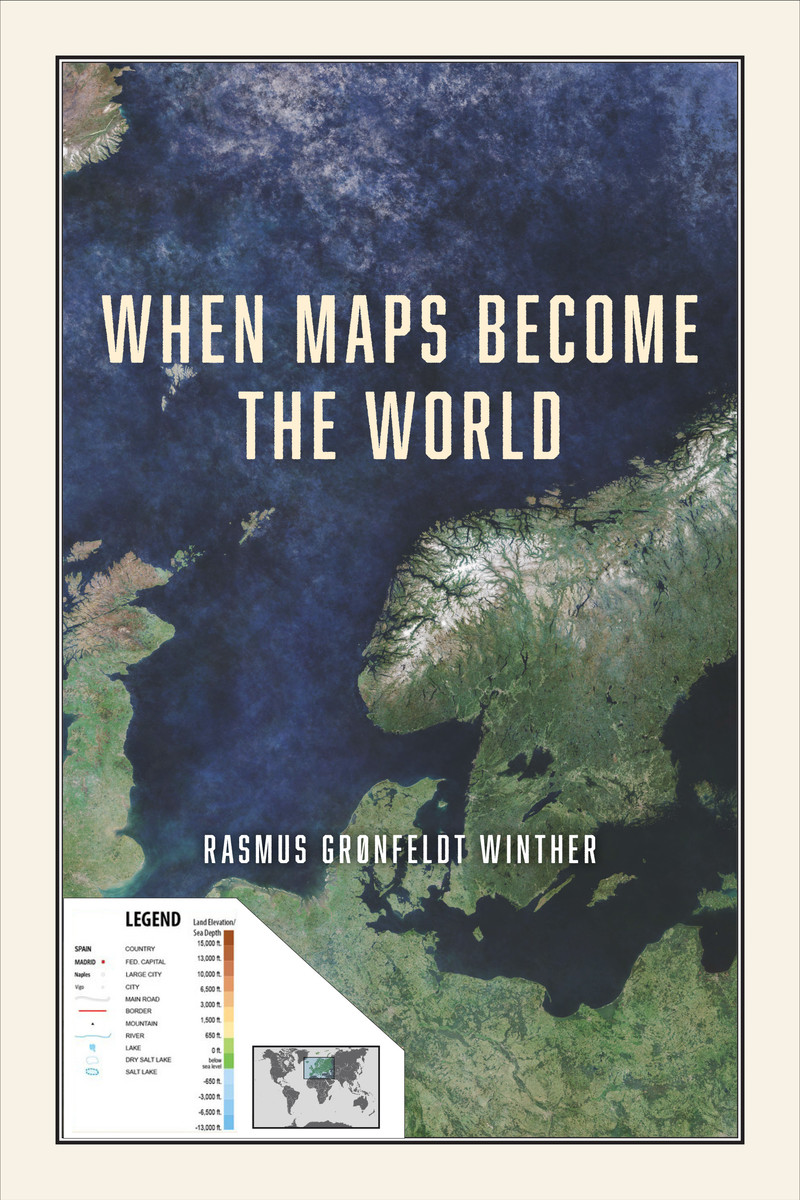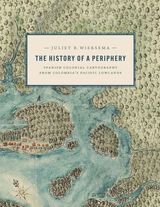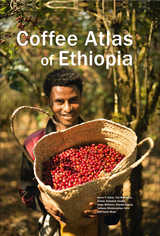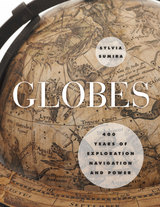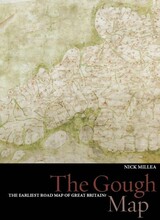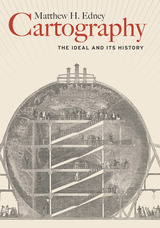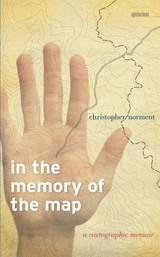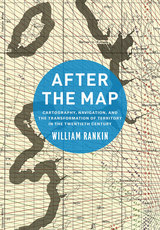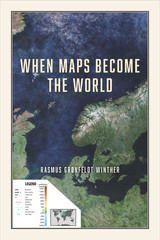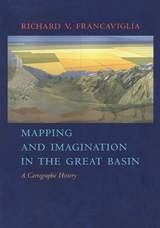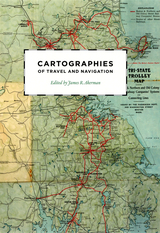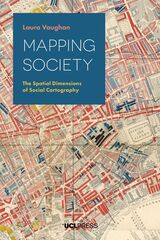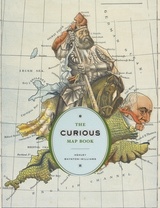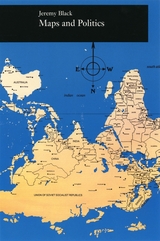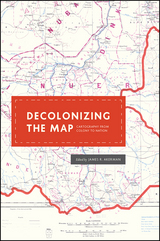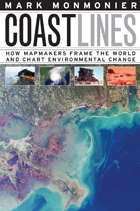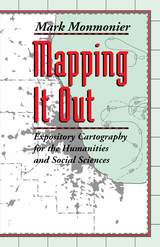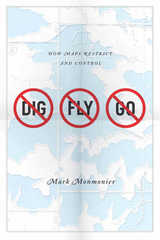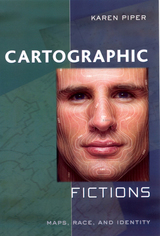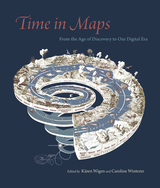When Maps Become the World
by Rasmus Grønfeldt Winther
University of Chicago Press, 2020
Cloth: 978-0-226-66967-0 | Paper: 978-0-226-67472-8 | eISBN: 978-0-226-67486-5
Library of Congress Classification GA102.3.W56 2020
Dewey Decimal Classification 526.01
Cloth: 978-0-226-66967-0 | Paper: 978-0-226-67472-8 | eISBN: 978-0-226-67486-5
Library of Congress Classification GA102.3.W56 2020
Dewey Decimal Classification 526.01
ABOUT THIS BOOK | AUTHOR BIOGRAPHY | REVIEWS | TOC | REQUEST ACCESSIBLE FILE
ABOUT THIS BOOK
Map making and, ultimately, map thinking is ubiquitous across literature, cosmology, mathematics, psychology, and genetics. We partition, summarize, organize, and clarify our world via spatialized representations. Our maps and, more generally, our representations seduce and persuade; they build and destroy. They are the ultimate record of empires and of our evolving comprehension of our world.
This book is about the promises and perils of map thinking. Maps are purpose-driven abstractions, discarding detail to highlight only particular features of a territory. By preserving certain features at the expense of others, they can be used to reinforce a privileged position.
When Maps Become the World shows us how the scientific theories, models, and concepts we use to intervene in the world function as maps, and explores the consequences of this, both good and bad. We increasingly understand the world around us in terms of models, to the extent that we often take the models for reality. Winther explains how in time, our historical representations in science, in cartography, and in our stories about ourselves replace individual memories and become dominant social narratives—they become reality, and they can remake the world.
This book is about the promises and perils of map thinking. Maps are purpose-driven abstractions, discarding detail to highlight only particular features of a territory. By preserving certain features at the expense of others, they can be used to reinforce a privileged position.
When Maps Become the World shows us how the scientific theories, models, and concepts we use to intervene in the world function as maps, and explores the consequences of this, both good and bad. We increasingly understand the world around us in terms of models, to the extent that we often take the models for reality. Winther explains how in time, our historical representations in science, in cartography, and in our stories about ourselves replace individual memories and become dominant social narratives—they become reality, and they can remake the world.
AUTHOR BIOGRAPHY
Rasmus Grønfeldt Winther is a philosopher of science, researcher, writer, educator, diver, and explorer.
REVIEWS
"An intriguing and often brilliant book, When Maps Become the World raises profound, even fundamental philosophical questions about ‘map thinking.’ The map is considered here as more than simply a scientific model or abstraction but as a kind of ‘metaperspective’ through which the world has been understood scientifically. This is an important book on how the map can be considered philosophically as a heuristic device that has enabled and constrained the development of scientific rationality."
— Michael Heffernan, University of Nottingham"When Maps Become the World deservedly takes its place alongside some of the great philosophical reflections on the unique alchemy of maps. This immensely rich and deeply learned book is about the power and limitations of maps and ‘map thinking’ as a way of understanding cartography as well as scientific theory and practice. Moving beyond the established critique of maps, Winther provides a dazzling route for new ‘map thinking’ in our bewildering digital age. A superb achievement."
— Jerry Brotton, author of A History of the World in Twelve Maps"A tour de force. Philosophers of science have increasingly resorted to analogies with maps and mapping in thinking about the relation of scientific theories and models to the world(s) they are about. Winther interrogates this usage in multiple ways: a historical overview of map-making in the West, a philosophical examination of the assumptions and commitments of map language, and in-depth studies of mapping practices in sciences from cosmology to neuroscience to genetics. Wonderfully enhanced by reproductions of maps from the many domains in which they are used, this book gives welcome philosophical substance to a widely used and increasingly central concept in studies of science."
— Helen Longino, Stanford University"Winther writes from a wide-ranging, multidisciplinary perspective to show the power of the map, mapping, and ‘map thinking’ to organize and understand complex information. In very clear prose, citing a rich literature, he explores the possibilities of mapping, as well as its limitations and hazards. Professionals in geographic information systems who read this book will expand their conception of mapping and see their work as integral to the entire human enterprise; they will reflect more deeply on what they are doing, how they do it, and why; and be encouraged to look further into the philosophical underpinnings of mapping and GIS."
— Jack Dangermond, founder and president, Esri"[Winther] blends wide-ranging, multidisciplinary perspectives to demonstrate the power of maps, mapping, and the philosophical 'map thinking' that helps explain complex information and relationships through scientific theories and models. Winther's text evaluates the promises, consequences, and perils of map thinking. . . . Winther's provocative, thoughtful treatise expands familiar concepts of cartography. GIS specialists could benefit from his reflections. . . . Highly recommended."
— Choice, 2020 Outstanding Academic Title"A sound contribution to the transdisciplinary field of map studies. . . . This book succeeds in bringing new theoretical insights into past cartographic materials and processes, encompassing diverse epochs, practices, and key ideas in map thinking. . . . The inclusive stance of this extremely well-written book is genuine, and the effort to bring together a huge amount of writings about cartography is valuable. From the specific angle of map theory, this book is a particularly welcome contribution that endorses a pluralistic style of thinking within the lively arena of map studies. From the point of view of science, it offers a sophisticated reflection on the generative powers of cartographic theorization."
— The Holocene"Convincingly links cartography and philosophy of science. . . . Winther relies on a careful archaeology of the basic or foundational assumptions lying behind every representation, and on 'counter-mappings': mappings that illustrate a minority or outsider point of view and thus show the contextuality of other maps. He illustrates his approach with examples of mapping in cosmology, brain research, and genetics. In doing so, he impressively shows the limitations the mapping of genes and brain functions have, and in which way 'counter maps' can open up new perspectives. . . . [The] book is an unorthodox and passionate plea for a diversity of perspectives—of structures, orders, and summaries—in cartography, science, and the philosophy of science. And at the same time, a convincing treatment of the tendency to confuse maps with the reality they describe."
— Frankfurter Allgemeine Zeitung"[Winther] has engaged fundamentally with mapping and cartography in order to show what significance maps play in all areas of science, how the clarification of spatial relationships helps in the formation of theory and representation of ideas in both the natural sciences and the humanities. . . . He never tires of giving hints to the danger of 'pernicious reification', the always erroneous equalization of a model with reality, regardless of whether it is the Mercator projection, the pictorial flattening of Earth in the atlas, gene-driven evolution or a model of Homo sapiens: The theory is never the Living."
— Süddeutsche Zeitung"An engaging and informative work. . . . I recommend this book to graduate students taking a history and philosophy of geography class, along with anyone else interested in this field."
— Cartographic Perspectives"A valuable contribution to the philosophy of scientific representation. . . . Winther's writing and reasoning is clear and engaging. For the most part, this book is widely accessible to non-expert readers. . . . [An] excellent book."
— History and Philosophy of the Life Sciences"It's only three-hundred pages but When Maps Become the World is a lot of book with a lot of thought-provoking propositions about life and how to live it. Masquerading as a book about maps and science, it's a manual on how to be in the world, a manual on how to live."
— Denis Wood, Making Maps: DIY Cartography"A valuable contribution to the philosophy of scientific representation."
— Springer Nature"Defining what a map is and how it works is a centuries-old exercise. Winther boldly goes where many have gone before and, after settling on a definition that allows for new directions, he explores how ‘map thinking’ operates to organize scientific knowledge and guide social change. Not only do maps represent the world we live in, but they also suggest multiple ways to remake it and, hopefully, improve it."
— Imago MundiTABLE OF CONTENTS
- Preface
1. Introduction: Why Maps?
A History and Philosophy of Map Thinking
The Nature of Map Thinking—Elements of Map Thinking—Deep Mapping—Five Hundred Years of Western Mapping
Maps Today
Cartography Meets GIS—A Definition Based on Representation—Characterizations Based on Process and Function
Three Maps
Waldseemüller’s Map—Guaman Poma’s Countermap—Van Sant’s Ultimate Map?
Conclusion
Part 1: Philosophy
2. Theory Is to World as Map Is to Territory
Analogy
Three Types of Analogy—Critical Cautions
The Map Analogy
A Typology of Map Analogies—Uses of the Map Analogy in Humanistic Inquiry
Assumption Archaeology
Conclusion
3. From Abstraction to Ontologizing
The Abstraction-Ontologizing Account
Abstraction
Abstraction Stage I: Calibration of Units and Coordinates—Abstraction Stage II: Data Collection and Management—Abstraction Stage III: Generalization
Ontologizing
Ontologizing 0: Representation Testing—Ontologizing I: Changing the World—Ontologizing II: Understanding the World—Ontologizing III: Classroom Communication
Conclusion
4. Long Live Contextual Objectivity!
Pernicious Reification
Contextual Objectivity
Conformation—The Essential Indexical
A History of the Mercator Projection I: Gerardus Mercator
Mercator’s Critique of Earlier Projections—Mercator’s New Purpose: Navigation—Mercator’s Clear Presentation of Latitude and Longitude—Mercator’s Awareness of Alternative Projections
A History of the Mercator Projection II: Post Mercator
Integration Platforms
A Beyond-Mercator Integration Platform: Blocking Pernicious Reification and Seeking Contextual Objectivity—Philosophical Aspects of Integration Platforms
Conclusion
5. Projecting Maps into Our Worlds
Two Canonical Philosophical Accounts of Representation: Isomorphism and Similarity
The Isomorphism Account—The Similarity Account
The Multiple Representations Account
Ontologizing—Merely-Seeing-As—Pluralistic Ontologizing—Climate Change and Multiple Representations
Conclusion
Part 2: Science
6. Mapping Space
Extreme-Scale Maps in Cosmology
The Universe’s Baby Portrait—The Universe Growing Up (and Outward)—Cosmic-Scale Maps and the Abstraction-Ontologizing Account
Literal Cartographic Maps in Geology
State-Space Maps in Physics and Physical Chemistry
Analogous Maps in Mathematics
Conclusion
7. Mapping Ourselves
Migration Maps
Arrowized Assumptions—Arrowized Maps—Countermapping Migration
Brain Maps
Decompositional Assumptions—Phrenological Maps—The Somatosensory and Motor Homunculi—Functional Magnetic Resonance Imaging (fMRI)—Countermapping the Brain
Statistical Causal Maps
Linear Model Assumptions—Correlation and Causation—“Genetic” and “Environmental” Diseases—Path Diagrams as Statistical Causal Maps—When Causal Maps Become the World
Conclusion
8. Mapping Genetics
Building a Mapping-Genetics Integration Platform
Assumptions—Terminology—Map Types
The Linear Genetic Map
Linear Genetic Maps of Phenotypic Linkage—Linear Genetic Maps of Nucleotides—Assumptions of the Linear Genetic Map
The Gene Expression Map
The Genotype-Phenotype Map
The Literal Cartographic Genetic Map
The Comparative Genetic Map
The Adaptive Landscape Map
An Analogous Genetic Map: The Tree of Life
Darwin’s Hypothesis—Contemporary Phylogenies
Future Extensions: Mapping Genetics as a Paradigmatic Integration Platform
9. Map Thinking Science and Philosophy
Existence, World Making, and Responsibility
Map Thinking Scientific Methodology
Map Thinking Philosophical Methodology
Assumption Archaeology—Tracking Ethics and Power—Imagining “What If . . . ?”
An Invitation to Dream
Appendix: Cognitive Map Exercise
References
Index
REQUEST ACCESSIBLE FILE
If you are a student who cannot use this book in printed form, BiblioVault may be able to supply you with an electronic file for alternative access.
Please have the accessibility coordinator at your school fill out this form.
It can take 2-3 weeks for requests to be filled.
See other books on: Abstraction | Cartography | Epistemology | Knowledge, Theory of | Mental representation
See other titles from University of Chicago Press
Nearby on shelf for Mathematical geography. Cartography / Cartography:
9781477327746
9780226422619
